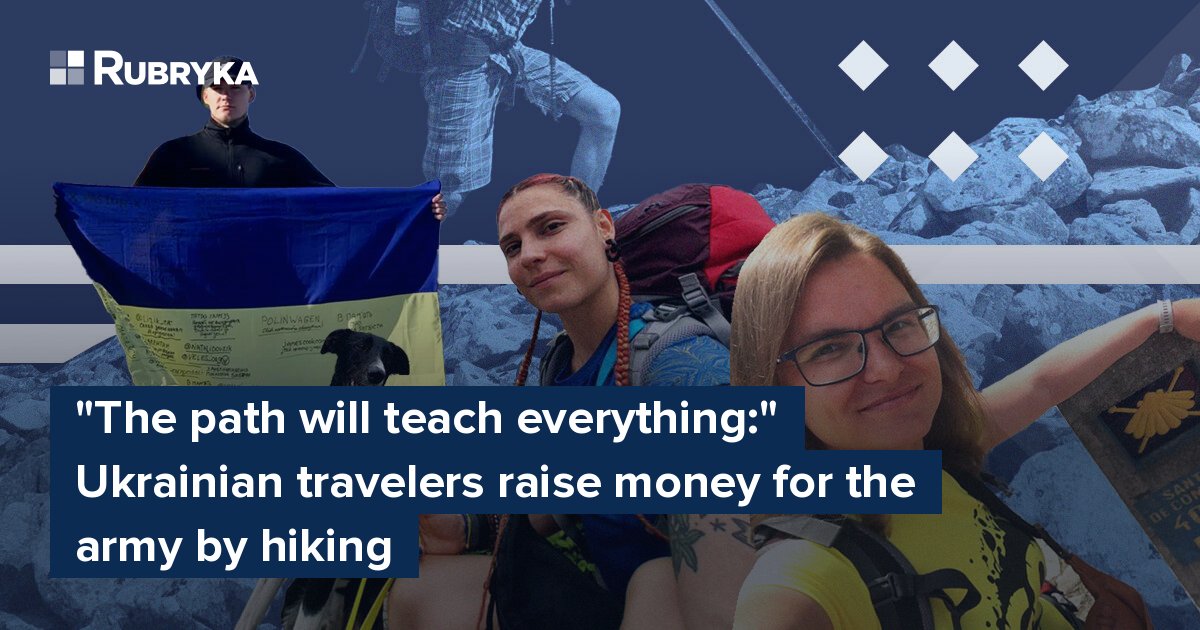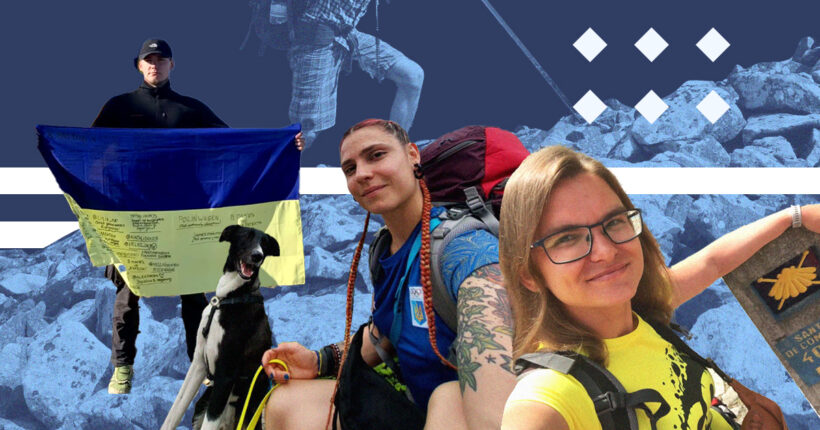
What is the problem?
Every day, many volunteer shipments are sent to the front and the hospital. All of them are the results of the joint efforts of Ukrainians. Some collect funds, others arrange the necessary equipment, make purchases, pack, and deliver, but the war continues, and the needs of soldiers are increasing.
What is the solution?
The idea of charity hikes is not new and is quite popular abroad, but with the beginning of the war, Ukraine picked up this trend. During the hike, activists fundraise money on specially opened accounts. For as many people as possible to learn about them, they talk about their travels on social networks.
To learn more about hiking, Rubryka spoke to Ukrainian hikers.
How does it work?
Vladyslav Pastushenko: from Kyiv to Hoverla
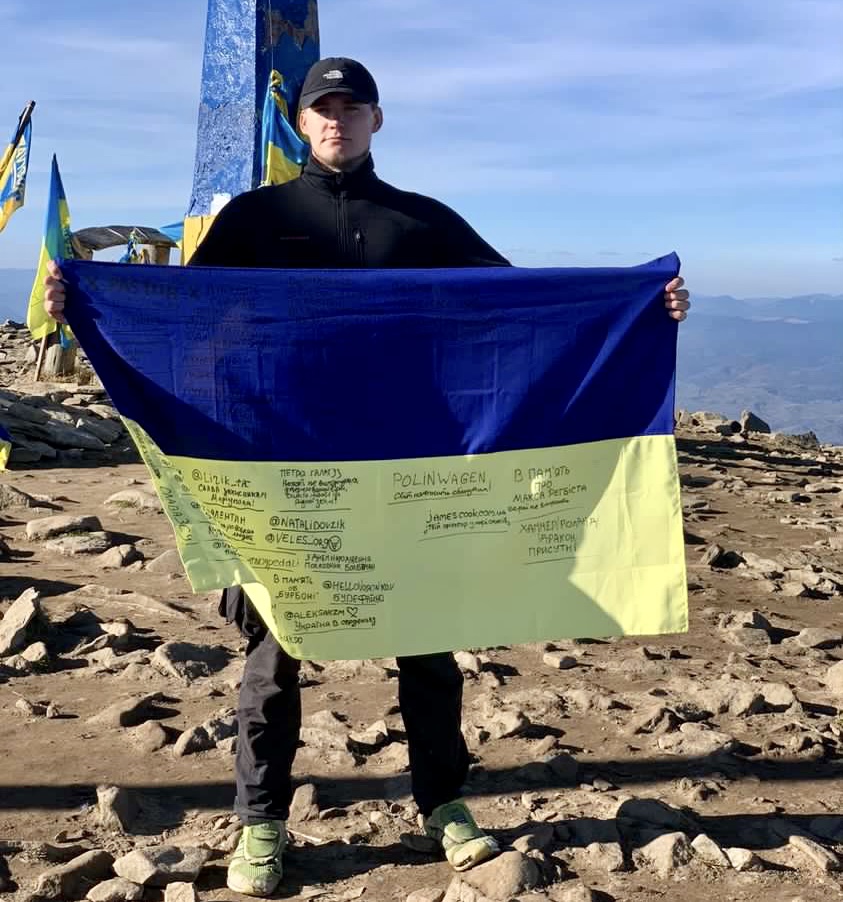
Vladyslav Pastushenko on Hoverla. Photo from Pastushenko's archive
24-year-old Vladyslav Pastushenko is a physical education teacher from Kyiv, specializing in organizing tourism activities. Before the war, he arranged tours to the Chornobyl exclusion zone and the mountains. Pastushenko has made 33 hikes in the Chornobyl zone and more than 20 mountain hikes.
The teacher planned to walk from Kyiv to the highest point in Ukraine back in 2018. Then he and his friends traveled from Vinnytsia to Hoverla — 420 km in 21 days. However, Pastushenko has been itching to repeat the journey with a starting point in the capital since then.
In the summer of 2022, he decided to go to Hoverla, but not for nothing. The main goal of the hike was to collect funds for two cars for the front.
"At that time, hiking was not yet so mainstream," says Pastushenko, "only one blogger did such a thing before. It was possible to start the journey in September. After all, it was necessary to collect start-up capital to purchase certain equipment and products. I had no doubts about the case's success — firstly, it was an interesting experience and self-testing. Besides, it should be interesting for people who will watch the mini-series about the adventure."
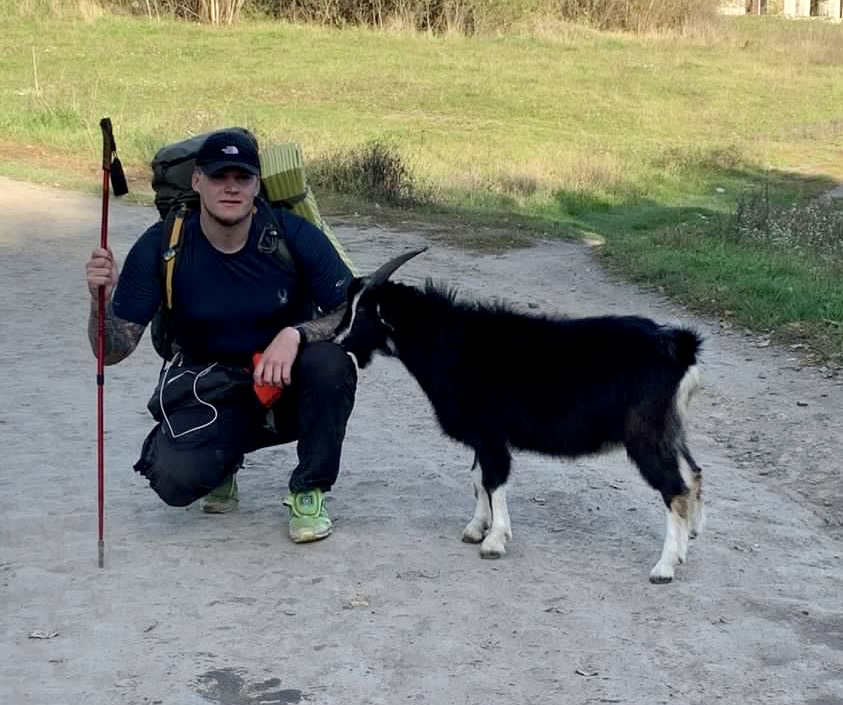
During the trip to Hoverla, Pastushenko made friends with goats. Photo from Pastushenko's archive
The fundraiser was held on different platforms, including Monobank, PrivatBank, and PayPal. The goal was to collect ₴500 thousand. The route was not easy. As Pastushenko admits, the most challenging thing was the monotony of the track. On the very first day, the traveler excoriated his skin with a shoulder pad — this brought a lot of discomfort for all the following days.
Sometimes it was impossible to ask for a night's accommodation, often in villages it was necessary to spend the night simply in a tent, the rains also added to the troubles. However, this was not always the case — for example, hotels made a discount or even offered a place to sleep for free after learning about the fundraiser, and followers' reposts, donations, and words of support added confidence and inspiration.
"There were also funny moments. I climbed the cave with bats and spent the night with them. Cuddled with goats and sheep, walked through forests and fields — here are so many beautiful places in Ukraine!" Pastushenko recalls.
He told people about Hoverla, who, before meeting the hiker, did not know what it was. He was afraid in the tent that the fox walking nearby would attack. In the Chernivtsi region, in the Vyzhnytskyi district, Pastushenko got into a strong swamp, where he almost lost his shoes. The hiker tells about all this with humor, even when he mentions the pessimistic 'beware of the bear' information posters that he saw on his way.
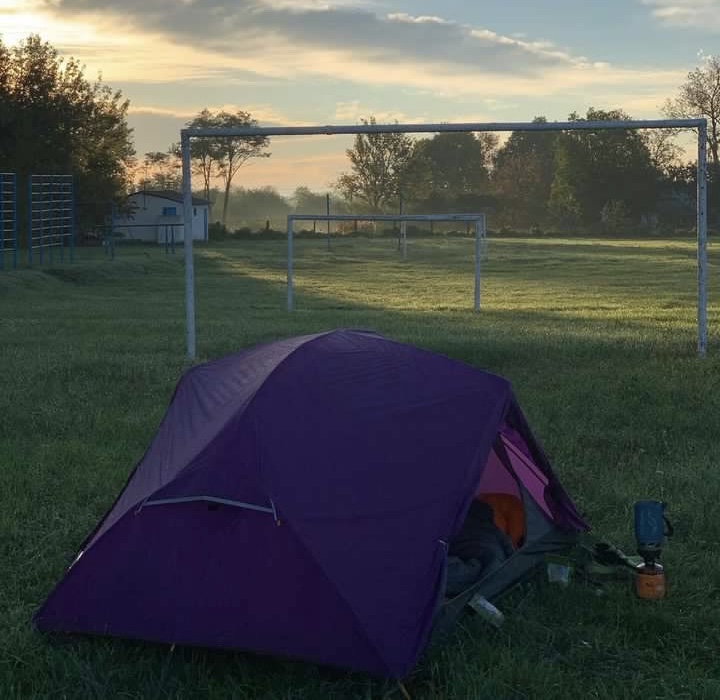
Overnight in a tent at the school stadium. Photo from Pastushenko's archive
The hiker had a plan to complete the route in 30 to 40 days but covered 700 km in 20 days. However, he couldn't collect the required amount, but the accumulated funds were enough for two cars — one for the military, whose task is to arrive, hit the enemy's equipment, and quickly get away. The other vehicle is for the second line of evacuation of the wounded.
"This experience taught me to finish things, to be alone with myself for more than one day, to solve my problems on my own, and to get out of any difficult situations," Pastushenko told Rubryka. "Maybe I would repeat this experience, but I would take a more scenic route because highways are boring. It's better to go in a group — then you have support, and a boring track can become more fun.
Kateryna Belkina: alone with a dog in Spain
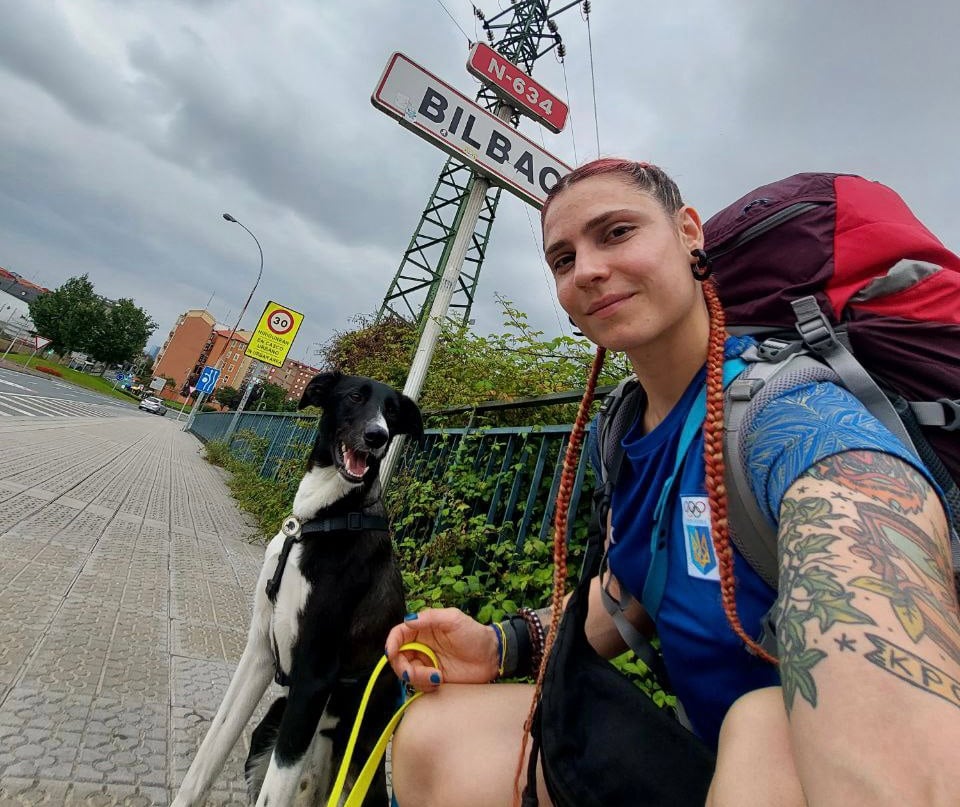
Bilbao is the beginning of the journey of Kateryna Belkina and Homey. Photo from Belkina's archive
Kateryna Belkina and her four-legged friend, the dog Homey, walked 783 km across Spain to raise funds for the Armed Forces of Ukraine. Belkina is the head of the non-governmental organization Open Cages Ukraine. She is an athlete, activist, and vegan who likes to travel and take pictures. The activist decided to walk the path of Santiago and thus help Ukrainian soldiers because, during the war, she saw that inspiration and an unshakable belief that together, we can change the world for the better really motivates people to donate.
"I heard about Santiago's path a long time ago or, rather, saw it in a movie. I thought: 'Wow! This is the thing I want to do!'. It seemed to me that now was the perfect time to leave and, at the same time, start fundraising for the Ukrainian army," Belkina recalls. She planned a constant flow of interesting content that people would notice and donate money to the Armed Forces of Ukraine.
Belkina got a dog during the war. She and her husband took him from the shelter. The dog became the activist's faithful companion on a charity trip to Spain. Homey is already quite an experienced traveler, with whom Belkina climbed Hoverla and went to Lake Nesamovyte — the highest mountain lake in the Ivano-Frankivsk region and one of the highest mountain lakes in the Ukrainian Carpathian mountains. Therefore, it was only necessary to resolve the issue of the dog's departure from Ukraine, which was the most difficult stage, to choose a route and ensure that everything was ready for the trip.
"Most of all, I was worried that it would be boiling; therefore, all the preparation was aimed at this aspect. I carried a water bottle for Homey, his food, and a t-shirt with a QR code so that on scorching days, I could put a wet t-shirt on him and cool him down that way," says Belkina. She chose the Camino del Norte of all the Santiago routes because it is the northernmost and not so hot due to its proximity to the ocean.
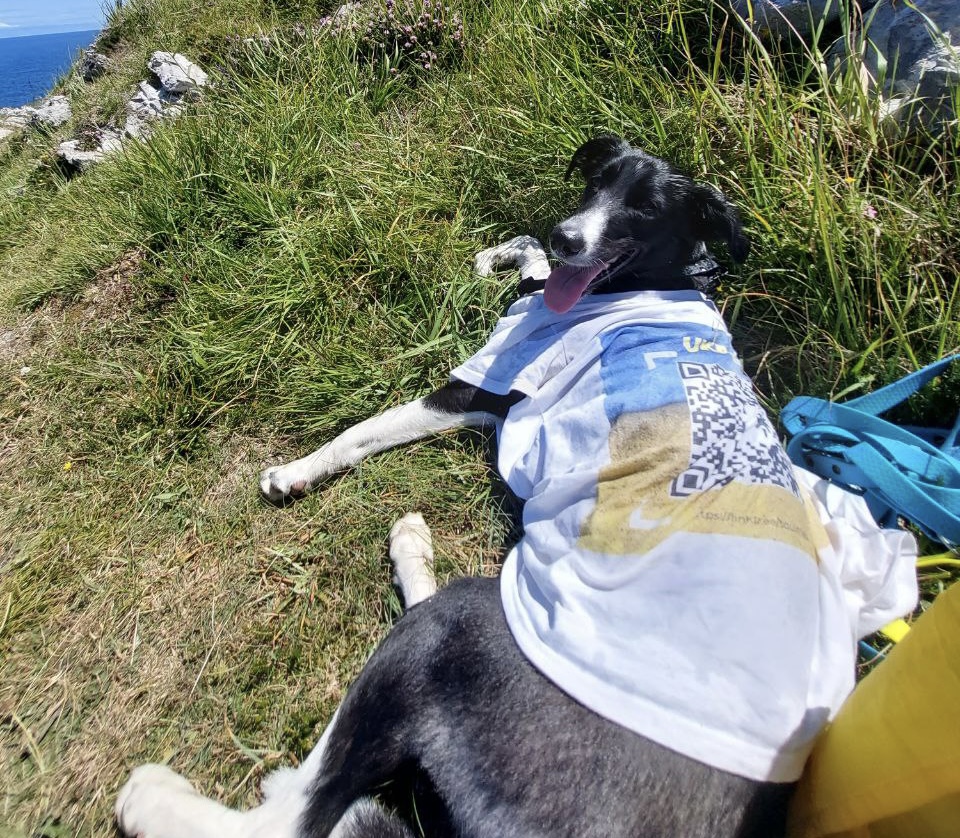
On hot days, Belkina stopped every 20 to 30 minutes. Photo from Belkina's archive
The traveler shared her and Homey's successes and adventures almost daily in a specially created Telegram channel. According to Belkina, broadcasting the journey was a big part of the success of the drone fundraiser for her husband, who is currently serving in the armed forces.
As far as strange situations go, there have been quite a few. One night, a traveler heard a peculiar sound, similar to the bleating of sheep but a little different.
"I thought it was most likely deer, and then I heard the sound of approaching hooves. Homey then also woke up and started barking in that direction," Belkina recalls. "The deer got scared and ran away, but, honestly, I don't know who was more scared: them or us."
Not only were the deer unhappy with Homey — Belkina writes on her channel that getting to the cafe or the beach area with the dog was often impossible. The pilgrims, however, were always willing to get to know the Ukrainian traveler and her dog. Australians, Portuguese, Canadians, French, Italians, and many others became the Belkina's company on various parts of the journey.
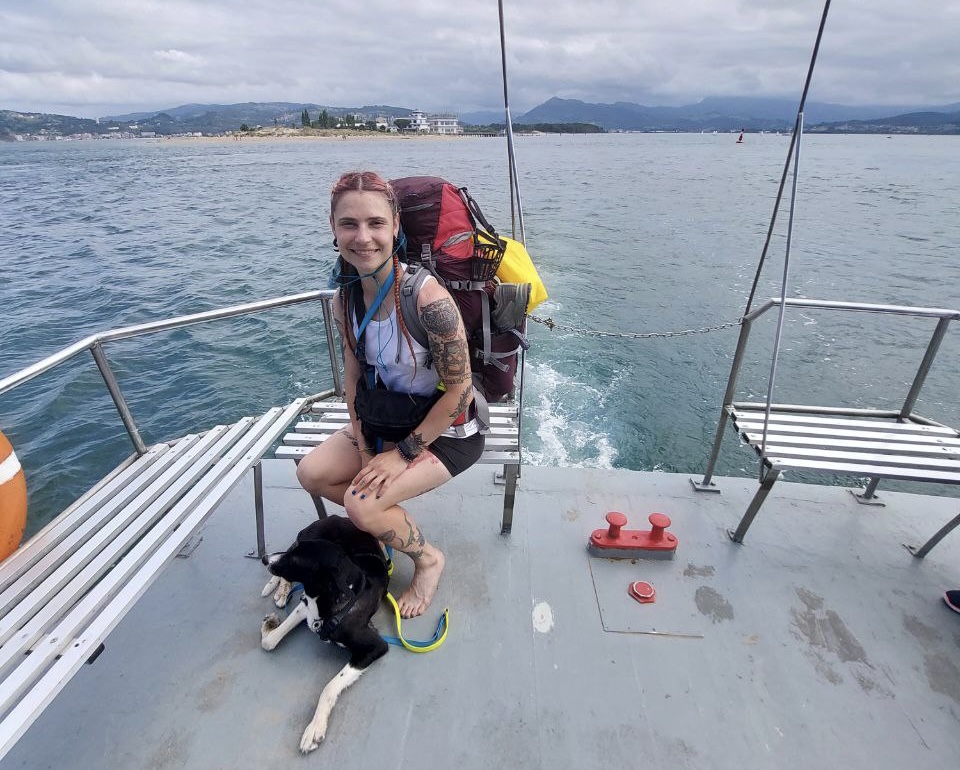
Crossing bays by boat is a common practice on the way to Santiago. Photo from Belkina's archive
The trip to Spain began on July 17. In mid-August, Belkina and her tailed companion finally reached home. The path ended with all objectives completed. A traveler with a furry friend walked the Way of Santiago — they covered 783 km and collected ₴260,000 for a drone for the Armed Forces of Ukraine. The activist finished the route and shared information about Ukraine and the war with the world.
"If you are just thinking about fundraising or already planning — don't worry and do it, because who else but us? Speak about the fundraiser on social networks, ask your friends to spread the word, and bring victory closer!" Belkina encourages others.
Petro Skrypka: collection for bionic prostheses
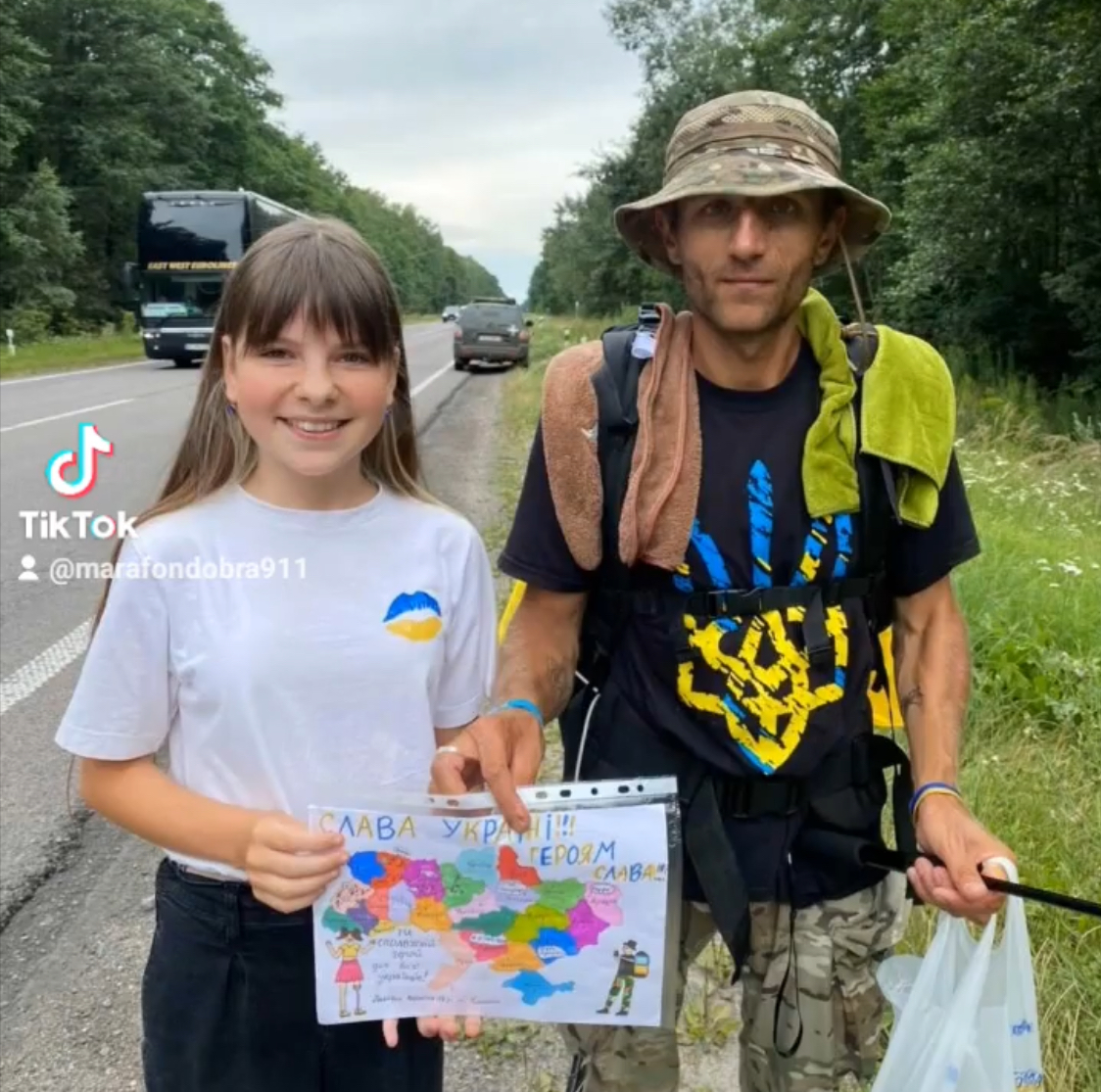
Petro Skrypka with one of his young subscribers. Photo from Skrypka's archive
Before the full-scale Russian invasion of Ukraine, Petro Skrypka worked as a storekeeper at a construction site. When the war started, he immediately joined the Territorial Defense. Then, he went to Zaporizhzhia to defend Ukraine. Having received an injury, he could not continue his service. Skrypka says the idea of a walking marathon appeared while undergoing treatment.
"When I was in the hospital, they brought a soldier from the front line — his legs failed," says Skrypka. The doctors promised his legs would be fine, but Skrypka saw how hard it was for him. He already knew he would be commissioned, so he decided to open a fundraiser for children and the military for bionic prostheses. In this way, he wanted to support them and remind them that many people had lost their limbs.
Skrypka started his marathon on July 12 in Kyiv and finished it on August 1 in Lviv. He covered more than 540 kilometers and walked an average of 30 to 40 kilometers per day.
"To overcome the path was not as difficult as it might seem," Skrypka shares, "It was hard during the first days, and then my legs got used to it and it was quite easy to walk." He was constantly broadcasting live on TikTok, which distracted the marathoner.
According to Skrypka, he somehow did not plan the trip — he just bought a backpack, packed the necessary things, and set off. He was carrying about 20 kg of weight. This weight increased depending on how many subscribers gave water or goodies along the way. The activist says that, in general, people on the road, when they heard about the purpose of the trip, helped a lot – with lodging and food. The drivers that passed by helped to get to a place to spend the night.
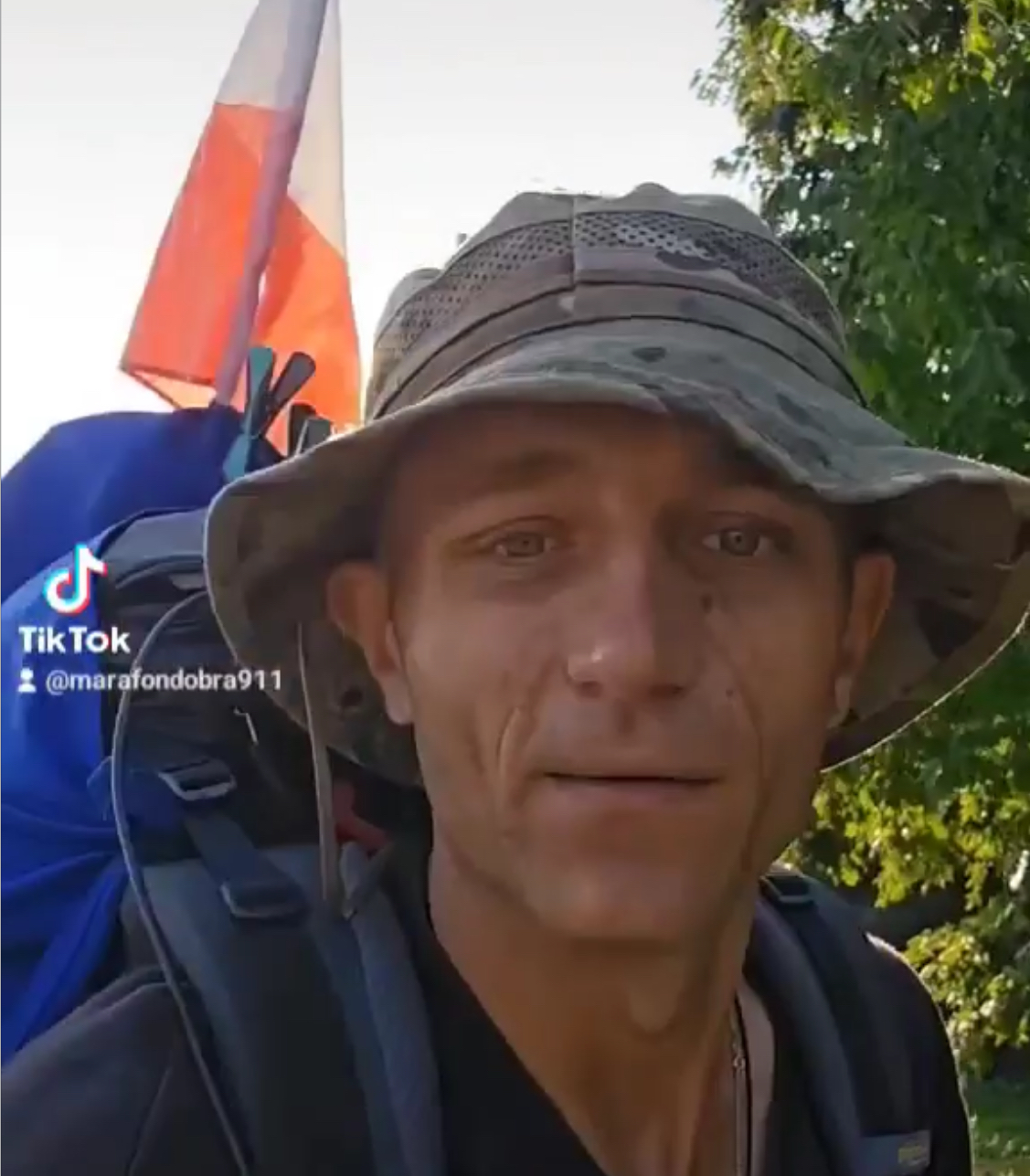
The next stage of the Skrypka's marathon is the Lviv-Warsaw distance. Screenshot from the video
During the campaign, Skrypka collected ₴720,000. Currently, ₴660,000 have been transferred to the Angels of Azov charity fund. The bank blocks another ₴60,000, but Skrypka and all his followers hope this issue will be resolved as well. Now, the traveler is overcoming another marathon stage — from Lviv to Warsaw. The goal of the marathon remains the same — to raise funds for the military and children who have lost limbs.
"I understand how difficult it is for such people in everyday life. Even though they will be supplied with prostheses, they still need support, especially moral support," Skrypka explained to Rubryka. "Unfortunately, the state does not have time to provide everyone with prostheses at once. People stand in queues for a long time, and this is also, especially for the military, a great psychological burden," says Skrypka and calls on all Ukrainians not to forget about this and to support Ukraine's heroes in every possible way.
For everyone who wants to join the fundraiser for people who have lost limbs, Skrypka provides banking details.
Khrystyna Mykhailiuk: the Way of St. James
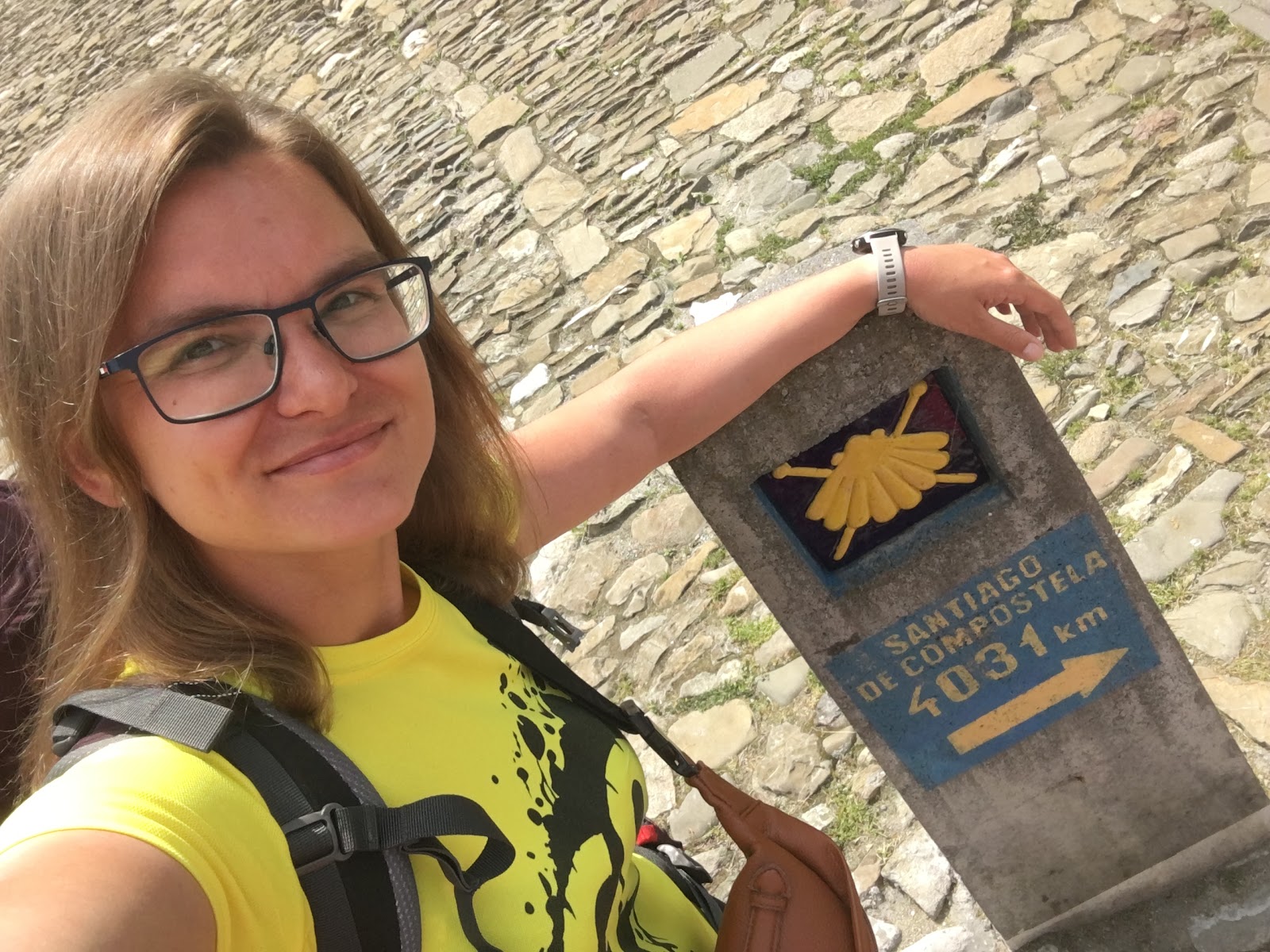
Khrystyna Mykhailiuk in Przemyśl. This is the last signpost on her path (it is the first on the Way of St. James if you move from Przemyśl to Santiago de Compostela). Photo from Mykhailiuk's archive
Khrystyna Mykhailiuk is from Zaliztsi in the Ternopil region, but now lives in Drohobych. She is a financier by education and has worked in IT for several years. Mykhailiuk embarked on a walking journey to collect ₴200,000 for the Ukrainian army. In 17 days, on the part of St. Jacob's route from Krakow to the border in Medyca, Mykhailiuk walked 525 kilometers.
"Apparently, most Ukrainians are trying to help the armed forces today in one way or another. At the beginning of the full-scale invasion, I was in Krakow, helping with donations and spreading the word about the fundraiser," the activist recalls. Then, every month, she went to Ukraine and took small transfers in both directions — she worked as a kind of courier, and the payment for the service Mykhailiuk Express was donated to the army.
This spring, Mykhailiuk decided to return to Ukraine. She knew about the Way of St. James (Camino de Santiago) for a long time and wanted to walk it. At first, Portugal or Spain was on her mind, but she learned that there are also branches of the road passing through Krakow, and one of the branches practically duplicates the route she used to travel home every month. In addition, Mykhailiuk had already heard about successful attempts to raise money for the army during hikes, races, and bicycle races — she also decided to try it.
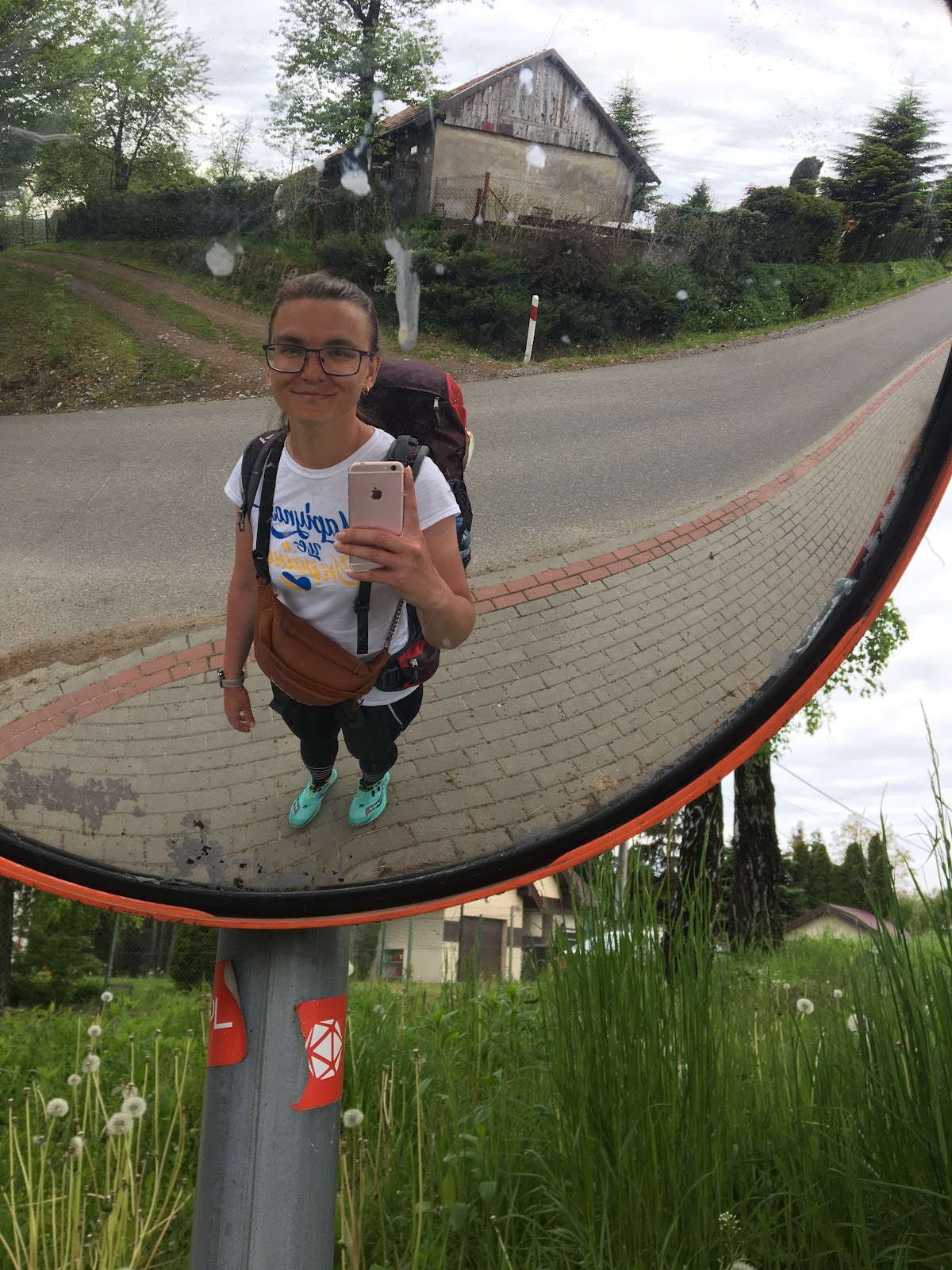
Khrystyna Mykhailiuk on the section between Tarnuv and Tuchów — the 7th day of the journey. Photo from the heroine's archive
It took a week from the decision to the start of the route, so no careful planning was involved. Mykhailiuk sent boxes of things from Poland to Ukraine, picked up her backpack, which her boyfriend had sent her, packed her things, and left. Another preparation point was watching videos and articles of travelers who had already completed the route. Since the hike took place in May with its most diverse weather, she had to take a lot of different clothes/shoes. In addition, the traveler's backpack contained a sleeping bag, a mat, makeup, some equipment, documents, a guidebook, snacks, and water — a total of 12 kg. Mykhailiuk walked an average of 30 km per day. She posted daily photo/video reports from the trip on her Instagram and Facebook pages.
"It was not difficult for me to leave. I'm a fan of walking, and I'm fine with being alone, too — there's time to think about different things. Many things in my plan involved acting on the situation," Mykhailiuk told Rubrylka. "At first, it was not always convenient to navigate the route according to road signs since I was essentially going in the opposite direction, but later I adapted. Moving through the forest alone was somewhat difficult and a little scary."
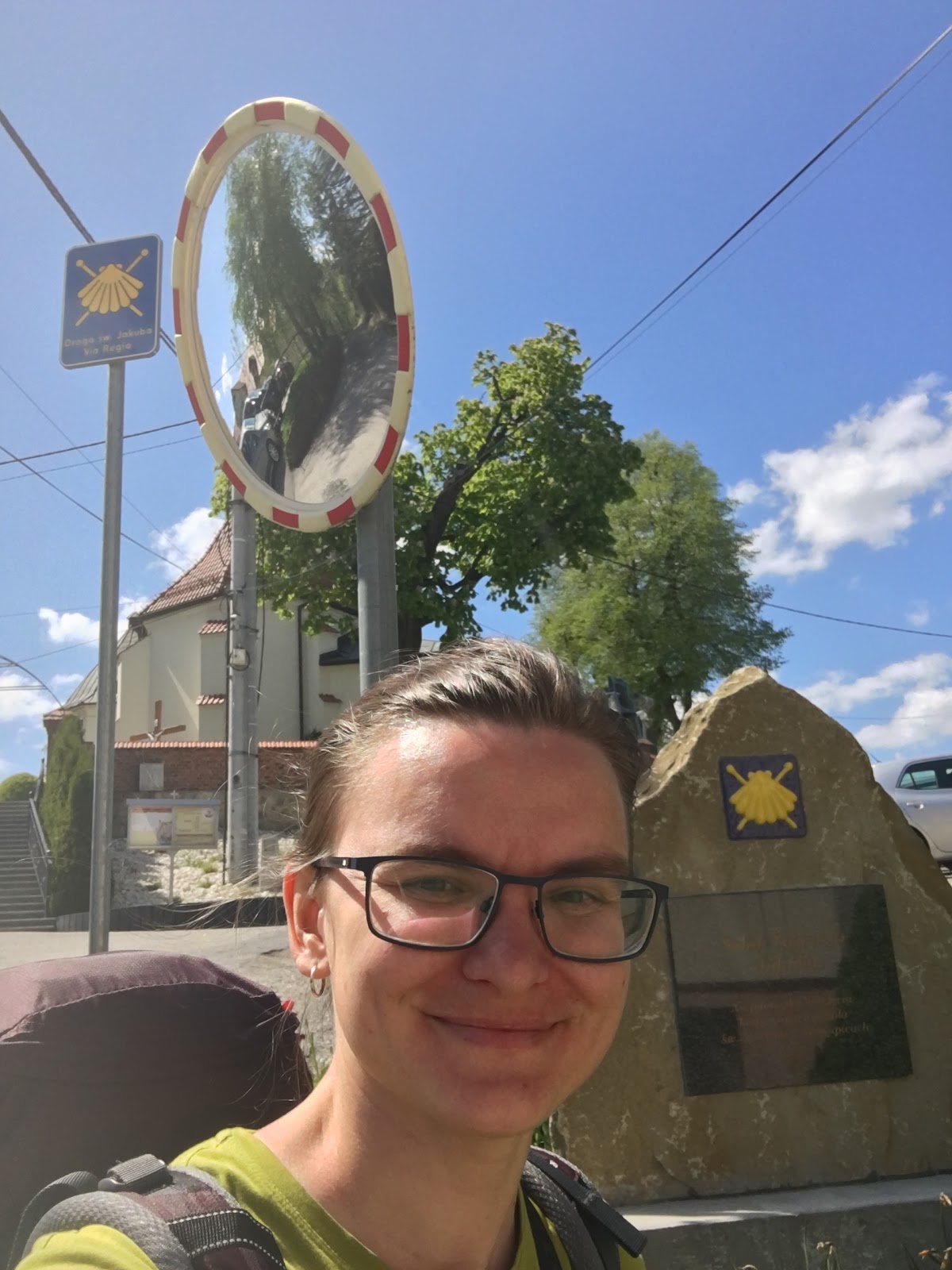
Saint Martin Church in the village of Biskupice, Poland. Photo from Mykhailiuk's archive
Along the way, the Ukrainian was often offered a lift, but she refused, even when, at the end of the journey, she tripped, fell, and sprained her leg because she intended to walk the entire route. Often, people with whom Mykhailiuk stayed for the night gave food for the journey, and some refused to take money at all, and others joined the fundraiser. Such support of the Poles, both in the campaign itself and in general during this war, inspired and gave strength.
During the route, the traveler collected half of the amount, but the fundraiser continued in Ukraine. During the summer, Mykhailiuk collected the desired ₴200 thousand and bought a Ford Ranger car for the 44th Artillery Brigade. At first, the target was a drone, but later, the needs at the front changed.
"In general, the fundraiser was going well, especially during the trip itself," says Mykhailiuk. "I received kind support from relatives who spread information and donated, and then support came from their acquaintances. Initially, I did not believe that the target amount would be collected, but, as they say, the eyes fear, but the hands do."
When the gathering slowed down a little, Mykhailiuk found some interesting information drives to activate people — quizzes, challenges, and raffles on Instagram started. "I volunteered at a trail event where the organizers decided to donate all the proceeds from the sale of buffs. I was asked to speak to the participants about the Camino at another trail camp. Thirty thousand hryvnias were collected at both events."
The fundraiser is not closed even now. Mykhailiuk collects for another car for the same battalion and uses all her marketing imagination — she cooks borscht, runs a half-marathon, organizes quizzes, and also constantly asks for advice/ideas from friends or blog readers — what they would be interested in reporting more often.
"I'm lucky," says Mykhailiuk, "because wonderful people surround me — they often put forward proposals themselves, prepare gifts for donation draws, and then donate. I once again make sure that if you want to, you can move mountains, especially if you are in a group. Support is important!".
Even more useful solutions!
Long-distance hiking has many nuances. Below, we have collected the advice of our heroes for those who want to repeat their experience and thus raise funds for the army.
Physical training and equipment
If you've never been to the mountains, haven't slept in a tent at least somewhere in the forest, aren't physically prepared, or don't know how to be with yourself, don't go, Pastushenko is sure. For those who dare, an experienced traveler advises to pay attention to physical training — run and walk a lot several months or at least a month before the main marathon. You should carefully draw up a route, find points to spend the night, and think about what to do if something does not go according to plan. Pay attention to your shoes and equipment — give preference to synthetic materials, as they dry faster and remove sweat or moisture from the body.
Mykhailiuk believes it is important to know your body's peculiarities, reactions, and possible emotions. Different things can happen along the way. In addition, she recommends:
- Simulate several adverse situations, think through your actions in them
- It is better to take tested clothes/equipment — those you have already used.
- Have electronic and paper maps.
Things should be as easy as possible, adds Skrypka. You definitely need a powerful power bank, especially if you want to broadcast.
Details and social networks
"I decided that it is necessary to make different payment methods, to choose which options will be comfortable for people. Monobank is the most convenient option for Ukrainians, but what about foreigners? You must already have PayPal and Buy me a coffee," Belikna shares her experience. "That's why I made different payment methods and collected all Linktree links for convenience."
Here are the tips from Mykhailiuk and Pastushenko:
- Choose a strategy of daily reminders on social networks — this way, the link to the bank is always available and in sight.
- Encourage people to repost.
- Prepare nice images with the announcement of the fundraiser and the information below it so that it is easier for people to repost and it looks more engaging.
In turn, Skrypka reminds: "You should understand that there will be not only support in social networks but also hate. They can pour mud on you and accuse you of stealing funds. People going on such a walking marathon should be ready for it. Also, people should be prepared that they will be asked to report, and they have to deliver this report in such a way that there is no doubt in it."
Road
Belkina says: "In the first days, don't walk for a long time — you need to adapt to the load and weather conditions. Pick up the pace, enjoy the road, and be open to people. The path will show everything and the path will teach everything. It's a very cool experience, and I would probably advise everyone to go through it at some point."


